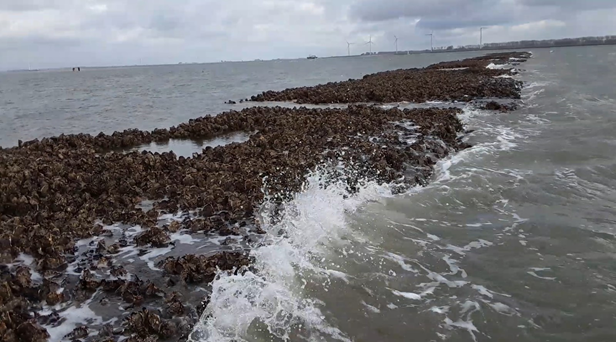B. Walles1*, B.C. van Prooijen2 , W.I. van de Lageweg1
1 Department of Technology, Water & Environment, Building with Nature Research Group, HZ University of Applied Sciences, The Netherlands
2Faculty of Civil Engineering and Geosciences, Delft University of Technology, The Netherlands
* Corresponding author: brenda.walles@hz.nl
Introduction
Globally, numerous oyster reefs are built for shoreline protection, but success varies widely. Existing studies either explore wave attenuation by oyster reefs or ecological constraints independently. As such, integration of engineering and ecological knowledge is lacking, hindering effective translation into erosion-control measures. To optimize oyster reef design as a nature-based erosion control measure in the face of climate change, it is essential to comprehend how wave attenuation mitigates erosion along the shoreline profile, considering oysters' ecological constraints. This holistic understanding will maximize both ecological and engineering outcomes in the application of oyster reefs for nature-based erosion control.
Objective and Methods
In 2010, three large scale (200m x 8m x 0.25m) oyster reefs were built in the Oosterschelde estuary as mitigation measure to counteract tidal flat erosion. Over the course of a decade, we measured reef development (recruitment, growth and survival), wave attenuation (in the close proximity of the reef (2010) and along a transect (2020)) and morphological changes in the area. Based on this long-term monitoring, crucial lessons were learned for advancing sustainable flood management strategies and gaining societal acceptance. By utilizing the data and insights, it is possible to model and validate the potential of a reef structure as an erosion control measure under various environmental conditions. As an example we demonstrate how reefs can be used as erosion mitigation measure at the Galgeplaat, a tidal shoal in the Oosterschelde which will be nourished in 2026. Oysters’ ecological constrain will determine where structures can last for decades and grow at the pace of sea level rise. Local bathymetry, erosion rate and wave climate will dictate to what extent reefs add to erosion control.
Results
One out of the three constructed reefs is still growing, whereas the others cease to exist. Emersion time is crucial for reef development and survival1. By applying this knowledge to four reefs in 2013 (Oesterdam), they are still present today. Reefs attenuate waves, which holds for hundreds of meters leeward of the reef. Wave attenuation by reefs is however, water-depth dependent. In microtidal systems, reefs can effectively reduce waves all the way to the shoreline; however, in mesotidal systems like the Oosterschelde, they only mitigate waves below a specific water level. Despite this, they do play an important role in erosion mitigation. At the Galgeplaat, reefs can provide protection to the lower part of the shoal at locations unsuitable for nourishments. While restricted to the lower intertidal zone, reefs serve as a crucial starting point in a cascade of ecosystems that collectively enhance coastal protection. More emphasis needs to be on how this adds to coastal resilience, as loss of one ecosystem threatens the next, as well as its ability to provide coastal protection. We pinpointed crucial parameters for designing, situating and optimizing nature-based defenses, advancing the knowledge of strategically placing restoration efforts.

Waves breaking on a decade old oyster reef at the Slikken van Viane in the Oosterschelde (Photo credits: Brenda Walles).
References
1Walles, B., Troost, K., van den Ende, D., Nieuwhof, S., Smaal, A.C., Ysebaert, T (2016). From artificial structures to self-sustaining oyster reefs. Journal of Sea Research: 108: 1-9 https://doi.org/10.1016/j.seares.2015.11.007.


